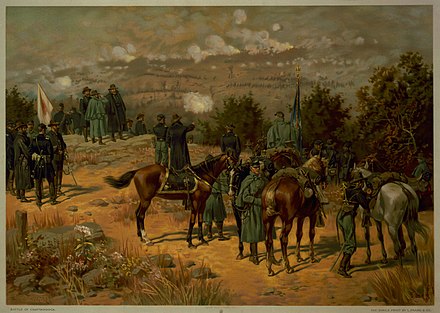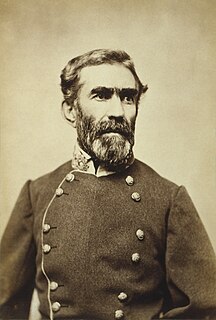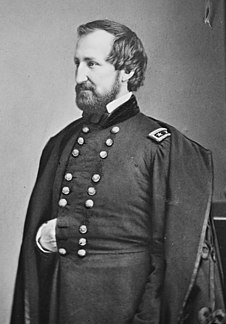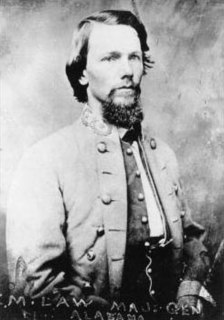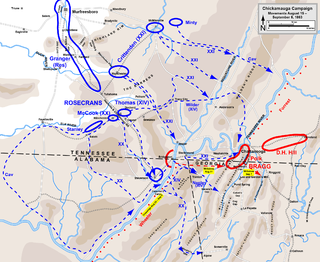| Chattanooga Campaign | |||||||
|---|---|---|---|---|---|---|---|
| Part of the American Civil War | |||||||
 Maj. Gen. Ulysses S. Grant and Gen. Braxton Bragg, commanding generals of the Chattanooga Campaign | |||||||
| |||||||
| Belligerents | |||||||
| Commanders and leaders | |||||||
| Ulysses S. Grant William S. Rosecrans George Henry Thomas William Tecumseh Sherman Joseph Hooker | Braxton Bragg | ||||||
| Units involved | |||||||
| Army of Tennessee | |||||||
| Strength | |||||||
| 72,533 "present for duty equipped" [2] | 48,948 "present for duty" [3] | ||||||
| Casualties and losses | |||||||
| 5,824 total | 6,000–8,000 (estimated) [5] (8,684 men killed, wounded or prisoners) [6] | ||||||
The Chattanooga Campaign [7] was a series of maneuvers and battles in October and November 1863, during the American Civil War. Following the defeat of Maj. Gen. William S. Rosecrans' Union Army of the Cumberland at the Battle of Chickamauga in September, the Confederate Army of Tennessee under Gen. Braxton Bragg besieged Rosecrans and his men by occupying key high terrain around Chattanooga, Tennessee. Maj. Gen. Ulysses S. Grant was given command of Union forces in the West, now consolidated under the Division of the Mississippi. Significant reinforcements also began to arrive with him in Chattanooga from Mississippi and the Eastern Theater. On October 19, Grant removed Rosecrans from command of the Army of the Cumberland and replaced him with Major General George Henry Thomas.

The American Civil War was a war fought in the United States from 1861 to 1865, between the North and the South. The Civil War is the most studied and written about episode in U.S. history. Primarily as a result of the long-standing controversy over the enslavement of black people, war broke out in April 1861 when secessionist forces attacked Fort Sumter in South Carolina shortly after Abraham Lincoln had been inaugurated as the President of the United States. The loyalists of the Union in the North proclaimed support for the Constitution. They faced secessionists of the Confederate States in the South, who advocated for states' rights to uphold slavery.
In the United States Army, United States Marine Corps, and United States Air Force, major general is a two-star general-officer rank, with the pay grade of O-8. Major general ranks above brigadier general and below lieutenant general. A major general typically commands division-sized units of 10,000 to 15,000 soldiers. Major general is equivalent to the two-star rank of rear admiral in the United States Navy and United States Coast Guard, and is the highest-permanent rank during peacetime in the uniformed-services. Higher ranks are technically-temporary ranks linked to specific positions, although virtually-all officers promoted to those ranks are approved to retire at their highest earned rank.

During the American Civil War, the Union Army referred to the United States Army, the land force that fought to preserve the Union of the collective states. Also known as the Federal Army, it proved essential to the preservation of the United States of America as a working, viable republic.
Contents
- Background
- Military situation
- Reopening the Tennessee River
- Preparations for battle
- Opposing forces
- Union
- Confederate
- The Battles for Chattanooga
- Orchard Knob
- Lookout Mountain
- Missionary Ridge
- Rossville Gap
- Retreat and pursuit
- Ringgold Gap
- Aftermath
- Battlefield preservation
- See also
- Notes
- References
- Memoirs and primary sources
- Further reading
- External links
After opening a supply line (the "Cracker Line") to feed his starving men and animals, Grant's army fought off a Confederate counterattack at the Battle of Wauhatchie on October 28–29, 1863. On November 23, the Army of the Cumberland advanced from the fortifications around Chattanooga to seize the minor high ground at Orchard Knob while elements of the Union Army of the Tennessee under Maj. Gen. William Tecumseh Sherman maneuvered to launch a surprise attack against Bragg's right flank on Missionary Ridge. On November 24, Sherman's men crossed the Tennessee River in the morning and then advanced to occupy high ground at the northern end of Missionary Ridge in the afternoon. The same day, Eastern Theater troops under Maj. Gen. Joseph Hooker defeated the Confederates in the Battle of Lookout Mountain. The next day they began a movement toward Bragg's left flank at Rossville.

The Battle of Wauhatchie was fought October 28–29, 1863, in Hamilton and Marion Counties, Tennessee, and Dade County, Georgia, in the American Civil War. A Union force had seized Brown's Ferry on the Tennessee River, opening a supply line to the Union army in Chattanooga. Confederate forces attempted to dislodge the Union force defending the ferry and again close this supply line but were defeated. Wauhatchie was one of the few night battles of the Civil War.

The Army of the Tennessee was a Union army in the Western Theater of the American Civil War, named for the Tennessee River. It should not be confused with the similarly named Army of Tennessee, a Confederate army named after the State of Tennessee.
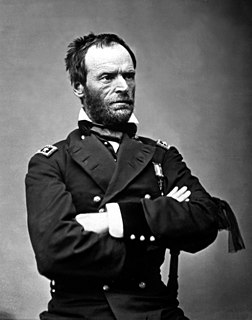
William Tecumseh Sherman was an American soldier, businessman, educator, and author. He served as a general in the Union Army during the American Civil War (1861–65), for which he received recognition for his outstanding command of military strategy as well as criticism for the harshness of the scorched earth policies he implemented in conducting total war against the Confederate States.
On November 25, Sherman's attack on Bragg's right flank made little progress. Hoping to distract Bragg's attention, Grant ordered Thomas's army to advance in the center of his line to the base of Missionary Ridge. A combination of misunderstood orders and the pressure of the tactical situation caused Thomas's men to surge to the top of Missionary Ridge, routing the Army of Tennessee, which retreated to Dalton, Georgia, fighting off the Union pursuit successfully at the Battle of Ringgold Gap. Bragg's defeat eliminated the last significant Confederate control of Tennessee and opened the door to an invasion of the Deep South, leading to Sherman's Atlanta Campaign of 1864.

Dalton is a city in Whitfield County, Georgia, United States. It is the county seat of Whitfield County and the principal city of the Dalton, Georgia Metropolitan Statistical Area, which encompasses all of Murray and Whitfield counties.

The Battle of Ringgold Gap was fought November 27, 1863, in northwest Georgia during the Chattanooga Campaign of the American Civil War. The Confederate victory by Maj. Gen. Patrick Cleburne gave the artillery and wagon trains of the Army of Tennessee safe passage to retreat through the "Ringgold Gap" mountain pass and caused high Federal casualties.

Tennessee is a state located in the southeastern region of the United States. Tennessee is the 36th largest and the 16th most populous of the 50 United States. Tennessee is bordered by Kentucky to the north, Virginia to the northeast, North Carolina to the east, Georgia, Alabama, and Mississippi to the south, Arkansas to the west, and Missouri to the northwest. The Appalachian Mountains dominate the eastern part of the state, and the Mississippi River forms the state's western border. Nashville is the state's capital and largest city, with a 2017 population of 667,560. Tennessee's second largest city is Memphis, which had a population of 652,236 in 2017.
























